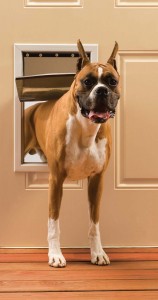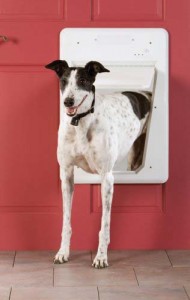We come and go from our houses daily, in and out, usually using keys. It’s part of being a busy human. The idea of giving your dog a key to the house probably sounds a little crazy, but in reality, it’s actually a possibility (except that key isn’t the keychain type). Electronic dog doors operate with that basic idea.
They allow your dog to come and go and permit him to enter based on an identifying “key” that he has in his collar. Sounds pretty cool, right? There are pros and cons to electronic dog doors that we’ll discuss in this article. Hopefully, we will give you some clarity on whether or not an electronic dog door is right for you and your pup.
In N’ Out: The Convenience of Electronic Dog Doors
Electronic Dog Doors: The Pros

Electronic dog doors, as we mentioned, open based on a transmitter located in your dog’s collar. When he tries to go through the door, which is installed on the lower half of your front door, it will electronically link with the transmitter on the collar and will open to let your dog through. When he returns, the door will let him back inside.
RELATED: 10 Best Dog Door for Walls and Doors
An electronic dog door has a lot of advantages. For one, it allows your dog some agency in determining where they go. You don’t have to hear him pawing at the door to be let out; he can just go without your assistance. It allows him to roam freely.
While non-electronic dog doors are nice, they do have their disadvantages when compared to mechanized ones. Dog doors left unlocked mean that anything can get in – a stray cat, a raccoon, an alligator if you live in Florida – this can lead to a whole host of problems.
Imagine waking up and there’s a raccoon raiding your fridge. The door works both ways when it is not electronic; however, when it is, only things that are supposed to be in the house can get in.
Electronic dog doors also work well for dogs that have arthritis or osteoporosis and can’t manage the non-electronic door, which requires effort to push open. Though that effort may not seem like a lot, for a dog experiencing joint and hip pain it can be a veritable nightmare. You want to make things as easy and convenient for your pet as possible.
Elderly and/or handicapped dogs don’t need to be locked inside and prevented from the fresh air. With an electronic door, they’re able to maneuver their way in and out the way a younger, healthier dog would. They can do it without the pain and extra effort required by a traditional dog door.
RELATED: How to Improve Quality of Life for Disabled Dogs

There are a lot of options when selecting an electronic dog door, and these options help make your choice simpler and less boxed in. The transmitter that will be used to signify to the door that your dog is trying to get in can be used in a variety of ways. For example, you can use a magnetic key, an implant, radio frequency, or RFID chips.
The magnetic key operates with either a magnetic field or a magnetic attraction where the lever is actually pulled downwards in response to your pet’s collar. An implant can be put in at the vet and will probably go in the collar region (though some pet owners are a little wary of implanting microchips into their dogs).
Radio frequency and RFID chips also operate on the collar by transmitting signals to the door being operated. The variation in transmitter types is a “pro” for electronic dog doors because it gives us as the owner more options to choose from. We can select a method that works best for us and our pet.
Another “pro” for electronic dog doors is the ease of housebreaking. Once you’ve trained your dog not to go in the house, you then offer him a way to go outside whenever he needs to. Your dog won’t have to be uncomfortable throughout the day because he's waiting for you to get home so he can relieve himself.
If you work long hours, a dog door is a great way to make sure your Fido gets to stretch his legs and use the bathroom whenever he needs to—no mess necessary and no waiting time required. Electronic dog doors offer your dog some freedom and versatility when it comes to spending time alone. It’s much more fun to be able to roam around the yard than having to wait all day to be let out.
Electronic Dog Doors: the Cons

Just like with any piece of equipment, there will always be some downsides, potential and otherwise, to be cognizant of before making a purchase. For one, electronics aren’t always reliable. Most of the time they are; but everything breaks down once in a while. It happens.
RELATED: 2015 Top 5 Best Dog GPS Collars
In order to make sure that your electronic dog door is working reliably, keep your eye on it and change the battery whenever the instructions say to change it. This may strike some owners as inconvenient, but it is important to take care of your equipment when you have it, so be aware that this diligence will be required of you if you own an electronic dog door.
Also, another disadvantage is that the dog door allows your dog outside anytime he pleases, and if you don’t have another fence set up he could run off or go into the street. Even if you don’t think that your dog would run off, there’s always a chance. Make sure that you have some sort of secondary barrier installed so that your dog doesn’t go outside and then get into trouble.
An electronic dog door is dangerous for dogs that can easily get out and go off into other areas where hunters, cars, other wild animals, and other dangers exist. Lastly, electronic dog doors do require installation and an alteration to your front door, so make sure you are okay with that labor requirement before choosing to purchase one.













